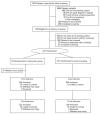Primary care-based intervention to reduce at-risk drinking in older adults: a randomized controlled trial
- PMID: 21143686
- PMCID: PMC3059722
- DOI: 10.1111/j.1360-0443.2010.03229.x
Primary care-based intervention to reduce at-risk drinking in older adults: a randomized controlled trial
Abstract
Aims: To examine whether a multi-faceted intervention among older at-risk drinking primary care patients reduced at-risk drinking and alcohol consumption at 3 and 12 months.
Design: Randomized controlled trial.
Setting: Three primary care sites in southern California.
Participants: Six hundred and thirty-one adults aged ≥ 55 years who were at-risk drinkers identified by the Comorbidity Alcohol Risk Evaluation Tool (CARET) were assigned randomly between October 2004 and April 2007 during an office visit to receive a booklet on healthy behaviors or an intervention including a personalized report, booklet on alcohol and aging, drinking diary, advice from the primary care provider and telephone counseling from a health educator at 2, 4 and 8 weeks.
Measurements: The primary outcome was the proportion of participants meeting at-risk criteria, and secondary outcomes were number of drinks in past 7 days, heavy drinking (four or more drinks in a day) in the past 7 days and risk score.
Findings: At 3 months, relative to controls, fewer intervention group participants were at-risk drinkers [odds ratio (OR) 0.41; 95% confidence interval (CI) 0.22-0.75]; they reported drinking fewer drinks in the past 7 days [rate ratio (RR) 0.79; 95% CI 0.70-0.90], less heavy drinking (OR 0.46; 95% CI 0.22-0.99) and had lower risk scores (RR 0.77 95% CI 0.63-0.94). At 12 months, only the difference in number of drinks remained statistically significant (RR 0.87; 95% CI 0.76-0.99).
Conclusions: A multi-faceted intervention among older at-risk drinkers in primary care does not reduce the proportions of at-risk or heavy drinkers, but does reduce amount of drinking at 12 months.
© 2010 The Authors, Addiction © 2010 Society for the Study of Addiction.
Conflict of interest statement
Authors report no conflict of interest.
Figures




References
-
- Saitz R. Unhealthy Alcohol Use. N Engl J Med. 2005;352:2139–2140. - PubMed
-
- Weyerer S, Schaufele M, Eifflaender-Gorfer S, et al. At-risk alcohol drinking in primary care patients aged 75 years and older. Int J Geriatr Psychiatry. 2009;24(12):1376–1385. - PubMed
-
- National Institute on Alcohol Abuse and Alcoholism. NIH Publication No. 07-3769. 2005. Helping patients who drink too much: A clinician’s guide.
Publication types
MeSH terms
Grants and funding
LinkOut - more resources
Full Text Sources
Medical
Miscellaneous

